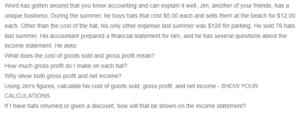Calculating Gross profit, Net Income, and Cost of Goods Sold
Unit 5 Discussion
The cost of goods sold refers to the direct costs incurred concerning producing the product sold. It is a separate cost from expenses in the income statement and is used to reduce sales or revenue (Vernimmen et al., 2022). When this is done, the gross margin profit is obtained. Gross profit is the profits the business makes when the costs incurred directly in making the goods are excluded. The formula for obtaining gross profits entails subtracting the cost of goods sold from sales revenue (Schroeder et al., 2022). For the case of Jim, the gross profit is given as follows:
Gross profit = Sales – Cost of goods sold
= (78*12) – (5*78)
= $936 – $390
= $546
Net profit = Gross profit – Operating expenses
= $546 – $120
= $426
In the above calculation, the sales revenue is $936, which is obtained by multiplying the number of hats sold by the selling price for each. The cost of goods sold is obtained by multiplying the cost of buying the hats by the number of hats purchased by Jim, which is $390. The difference between the sales revenue and cost of goods sold is $546, which is the gross profit. The net profit for Jim is $426, which is obtained as a difference between the gross profit and operating expenses. The income statements should show gross profit and net income because they offer insight into the business’s profitability (Welc, 2022). Notably, the business owner can decide which costs to reduce to enhance profitability.
In Jim’s case, if buyers return hats, they will be shown as sales returns in the income statement. Returned hats will reduce sales revenues and gross profit (Palepu et al., 2020). On the other hand, discounts will be considered expenses that will be used to reduce the gross profit as an expense in the income statement.
References
Palepu, K. G., Healy, P. M., Wright, S., Bradbury, M., & Coulton, J. (2020). Business analysis and valuation: Using financial statements. Cengage AU.
Schroeder, R. G., Clark, M. W., & Cathey, J. M. (2022). Financial accounting theory and analysis: text and cases. John Wiley & Sons.
Vernimmen, P., Quiry, P., & Le Fur, Y. (2022). Corporate finance: theory and practice. John Wiley & Sons.
Welc, J. (2022). Financial statement analysis. In Evaluating Corporate Financial Performance (pp. 131-212). Palgrave Macmillan, Cham.
ORDER A PLAGIARISM-FREE PAPER HERE
We’ll write everything from scratch
Question

Calculating Gross profit, Net Income, and Cost of Goods Sold
Word has gotten around that you know accounting and can explain it well. Jim, another of your friends, has a unique business. During the summer, he buys hats that cost $5.00 each and sells them at the beach for $12.00 each. Other than the cost of the hat, his only other expense last summer was $120 for parking. He sold 78 hats last summer. His accountant prepared a financial statement for him, and he has several questions about the income statement. He asks:
What does the cost of goods sold and gross profit mean?
How much gross profit do I make on each hat?
Why show both gross profit and net income?
Using Jim’s figures, calculate his cost of goods sold, gross profit, and net income – SHOW YOUR CALCULATIONS.
If I have hats returned or given a discount, how will that be shown on the income statement?

